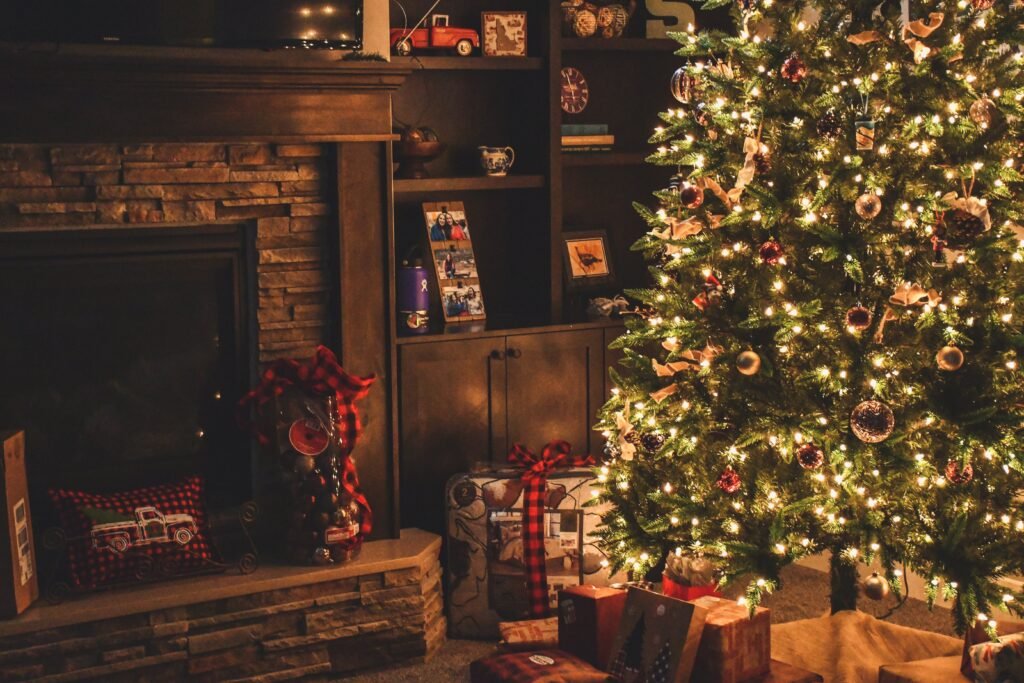Imagine stepping into your living room on a chilly winter evening, feeling the warmth and hearing the crackling sound of a roaring fire in your fireplace. It’s a cozy comfort that can instantly create a soothing and inviting atmosphere. However, it’s important to remember that while fireplaces can add to the ambiance of your home, they also pose potential risks. In this article, we will explore the top fireplace safety precautions that every homeowner should consider to ensure a secure and enjoyable fireplace experience. From regular maintenance to proper usage, these precautions will help you create a safe and cozy environment for you and your loved ones.

This image is property of images.pexels.com.
Choosing the Right Fireplace
When it comes to choosing the right fireplace for your home, there are several factors to consider. The first step is to determine the type of fireplace that best suits your needs. There are several options available, including traditional wood-burning fireplaces, gas fireplaces, electric fireplaces, and even ethanol fireplaces. Each type has its own advantages and disadvantages, so it’s important to do your research and choose wisely.
Additionally, it’s crucial to check for safety certifications before making a purchase. Look for fireplaces that have been certified by reputable organizations such as Underwriters Laboratories (UL) or the Canadian Standards Association (CSA). These certifications ensure that the fireplace meets all safety standards and has undergone rigorous testing.
Lastly, opt for a professional installation to ensure that your fireplace is properly installed and functioning correctly. A professional installer will have the expertise and knowledge to safely install your fireplace, taking into account factors such as ventilation, clearance requirements, and fuel source. This will give you peace of mind knowing that your fireplace is installed correctly and operating safely.
Maintaining a Safe Environment
Once you have chosen and installed your fireplace, it’s important to maintain a safe environment around it. One of the key safety precautions is to keep the area around the fireplace clear. Remove any flammable materials such as furniture, curtains, or decorations from the immediate vicinity of the fireplace. This will help prevent accidental fires and ensure that the surrounding area is safe.
Additionally, installing a sturdy fireplace screen is essential to prevent sparks and embers from escaping and causing potential harm. A screen acts as a barrier, keeping flames contained while still allowing heat to radiate into the room.
Lastly, always use proper fuel and materials in your fireplace. If you have a wood-burning fireplace, only burn dry and seasoned firewood. Wet or green wood can create excessive smoke and creosote buildup, increasing the risk of chimney fires. If you have a gas or electric fireplace, make sure to use the recommended fuel or logs specified by the manufacturer.
Proper Fireplace Use
When it comes to using your fireplace, there are several safety precautions to keep in mind. First and foremost, never leave a fire unattended. Always extinguish the fire completely before leaving the room or going to bed. This will help prevent accidental fires and ensure the safety of your home.
It’s also important to avoid overcrowding the fireplace with too much wood or other combustible materials. Overloading the fireplace can cause excessive heat and potentially lead to a fire hazard. Follow the manufacturer’s guidelines for proper wood or fuel placement to ensure safe and efficient operation.
Proper ventilation is another crucial aspect of fireplace safety. Make sure that your fireplace has adequate ventilation, whether it’s through an open chimney or a vent in the wall. Good airflow helps prevent the buildup of harmful gases like carbon monoxide.
Fireplace Maintenance
To keep your fireplace in optimal condition and ensure its safety, regular maintenance is necessary. This includes cleaning the fireplace and chimney on a regular basis. Over time, a buildup of creosote, a highly flammable substance, can occur in the chimney. Regular cleaning helps remove this buildup and reduces the risk of chimney fires.
In addition to cleaning, scheduling professional inspections is important. A certified chimney sweep or fireplace technician can thoroughly examine the fireplace and chimney, checking for any signs of damage or potential hazards. They can also clean hard-to-reach areas and make any necessary repairs or replacements.
Lastly, if you notice any damaged or worn-out parts, it’s important to replace them promptly. This includes things like cracked glass doors, broken chimney caps, or damaged flue liners. Ensuring that all components are in good working condition is essential for maintaining a safe and efficient fireplace.

This image is property of images.pexels.com.
Handling Firewood
Properly handling firewood is crucial for maintaining fireplace safety. When storing firewood, it should be stacked away from the house and protected from the elements. A dry and well-ventilated woodshed or storage rack is ideal for keeping firewood dry and ready to burn.
Only burn seasoned firewood in your fireplace. Seasoned firewood refers to wood that has been properly dried for at least six months. Burning wet or green wood can create excessive smoke, release harmful gases, and lead to faster creosote buildup in the chimney.
It’s important to note that treated or painted wood should never be burned in a fireplace. These types of wood can release toxic chemicals when burned, posing a risk to both your health and the environment.
Preventing Carbon Monoxide Poisoning
Carbon monoxide (CO) is a colorless, odorless gas that can be deadly if inhaled in high concentrations. To prevent carbon monoxide poisoning, it’s essential to install carbon monoxide detectors in your home. These detectors will sound an alarm if elevated levels of carbon monoxide are detected, giving you valuable time to evacuate.
Proper ventilation is also key in preventing carbon monoxide buildup. Make sure that your home is adequately ventilated, especially in areas where combustion appliances, including fireplaces, are located. Ensure that there is proper airflow and that vents are not blocked or obstructed.
Blocking ventilation sources can lead to the accumulation of carbon monoxide in your home. Avoid placing furniture, curtains, or other objects in front of vents or blocking the flow of air. This will help maintain proper ventilation and keep your home safe from carbon monoxide.

This image is property of images.pexels.com.
Child and Pet Safety
When it comes to fireplace safety, it’s important to take extra precautions when there are children or pets in the home. Creating a safe zone around the fireplace is crucial to prevent accidental contact with hot surfaces. Place a barrier such as a safety gate or screen to keep children and pets away from the immediate vicinity of the fireplace.
For additional protection, use protective barriers designed specifically for children. These barriers can be installed around the fireplace, preventing children from getting too close to the heat source. Make sure to choose barriers that are sturdy and childproof to ensure maximum safety.
It’s also important to educate children about fireplace safety. Teach them about the potential dangers of fire and the importance of not playing with the fireplace or its components. Educating children from an early age can instill a sense of responsibility and caution when it comes to fire safety.
Fireplace Safety Accessories
Investing in the right fireplace safety accessories can provide an extra layer of protection for your home. A quality fire extinguisher is a must-have in case of emergencies. Make sure to choose a fire extinguisher that is appropriate for extinguishing different types of fires, such as those caused by wood, gas, or electrical components.
Keeping a non-flammable rug or mat nearby is another important safety measure. This can help prevent accidental burns or damage to flooring in case of sparks or embers landing outside the fireplace. Choose a rug or mat that is made from non-combustible materials for maximum safety.
Having a fireplace tool set is also essential for safe and efficient fireplace use. This set typically includes tools such as a poker, brush, shovel, and tongs, which are crucial for maintaining and tending to the fire. Store the tool set in a convenient location near the fireplace, making them easily accessible whenever they are needed.
Emergency Preparedness
In case of a fire or emergency, being prepared is crucial. Make sure to have a fire escape plan in place for your home. This plan should include clear evacuation routes, designated meeting points outside the home, and instructions on how to safely exit the building. Regularly practice fire drills with all household members to ensure everyone knows what to do in case of a fire.
Keep emergency numbers, such as those of the fire department and poison control, handy near the fireplace or in a visible location. This will ensure that you can quickly and easily access these numbers in case of an emergency.
Regularly practicing fire drills can help familiarize all household members with the escape plan and ensure that everyone knows their roles and responsibilities. This will help minimize panic and confusion in the event of a fire and increase the chances of a safe and successful evacuation.
Educating Household Members
One of the most important aspects of fireplace safety is educating all household members about the potential risks and necessary precautions. Teach your family about fireplace safety, including how to properly use the fireplace, what materials to burn, and what to do in case of an emergency.
It’s also crucial to train household members on fire prevention. This includes practicing safe fire habits, such as not leaving flammable items near the fireplace, not using the fireplace as a source of heat overnight, and properly extinguishing fires before leaving the room or going to bed.
Regularly discuss emergency procedures with your family to ensure that everyone understands their roles and knows what to do in the event of a fire. Reinforce the importance of following the fire escape plan, calling emergency services if necessary, and staying calm and collected during an emergency situation.
By following these fireplace safety precautions and educating your household members, you can create a cozy and secure environment for everyone to enjoy. Remember, the key to fireplace safety is being proactive, practicing good habits, and taking the necessary precautions to prevent accidents and ensure the well-being of your home and loved ones.




